

Project «Voices of Jewish settlements. Vitebsk region.»פיתוח קשרי התרבות בין העמים של ישראל ובלרוס
|
|---|
Website search |
|
MainNew publicationsContactsSite mapVitebsk regionMogilev regionMinsk regionArkady Shulman
|
Arkady ShulmanLIOZNO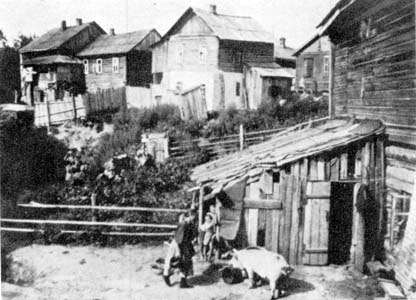 Old Liozno.
Old Liozno.
Liozno is a small town, until recently never visited by foreign tourists. When the first tourists appeared here at the end of the 90s, they were stared at as aliens from another planet. We were walking the streets of the quiet town and felt at peace - we were surrounded by beauty. It looked like a genius painted pictures and put them next to each other, building the streets and planting the trees. Even the fences with peeling paint and a never-drying puddle next to the water pump only added beauty to the composition. One of the German guests said: - This place is made for painters. I wish Liozno still had its open airs, which would attract painters from all over the world to visit Mark Chagall’s birthplace and work here. Beauty contains tremendous power and gives birth to new beauty. The painters, coming to the open airs would leave some of their paintings in this fascinating town. What a gallery could be here! Several years ago a memorial plate was hung on the building of the regional community center. It has the following inscription: “Here stood the mansion of the family, from which Mark Chagall originated.” 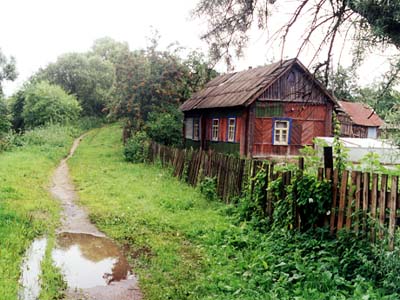 Liozno.
Liozno.
Filmmakers from Russia, France and even the distant Japan have visited the town. In fact, Japanese filmmakers came here twice – they loved Chagall’s town. Today Liozno has been added to many tourist lists. Once, I saw a painting called “Liozno” at an exhibition called “Mark Chagall’s landscapes”. The painting was created in 1911 in ink. There is a cart on a road. It is most probably driven by uncle Nekh, the one who used to buy cattle in the neighboring villages. He is pulling the reins, stopping the horse. The painter jumps off the cart and looks far into the distance. At the bottom Mark Chagall made an inscription “I’m enjoying nature in the evening. Liozno”. Looking at this picture I had a crazy idea: I need to climb that cart and move on together with the painter and his uncle. But our first destination would not be Mark’s relatives, even though I am certain that they would welcome us with a nice lunch and sincere conversations. First we would travel the bumpy roads of time deep into decades and centuries… 500 years ago a prince of the Great Duchy of Lithuania started building this town. The local residents admired the skills of craftsmen who came to build it, but secretly called them “Liozny”, which meant “alien”. According to the legend the name of the town originated from this word.  Liozno.
Liozno.
They say that the River Moshna used to be much wider in the old times and boats used to sail it, transporting flax, hemp, honey and other goods to fairs in Vitebsk, Riga and sometimes even to Scandinavian countries. The same river was used for transporting timber. As a rule the things that attract business people, also attract the military. Liozno has always been both “a cherry on the cake” and “a hard nut” for those who wanted to conquer it. The major wars that have ever taken place in Europe also reached this place, leaving wounds in people’s souls. The town witnessed enormous battles, which determined the historical process. Initially the State of Moscow fought for the place with the Great Duchy of Lithuania. Later Napoleon’s army faced the Russian army here, after conquering all of Europe. In the Second World War Liozno was in the front line for nine months. When the Soviet Army finally broke through and moved westwards it meant the war was practically over. The first Jews settled in Liozno when the town belonged to Lev Samuel Oginsky. It is doubtful that anyone can specify today the exact date when it happened, no documents can give evidence, but supposedly it happened in the first quarter of the 17th century. In 1745 a boy was born here in the family of Boruh Pozner and his wife Rivka. They named him Shneur-Zalman. This man became the founder of a new religious and philosophical doctrine HaBaD and the first Lubavichi rabbi, the founder of a dynasty of spiritual leaders in the Jewish world. 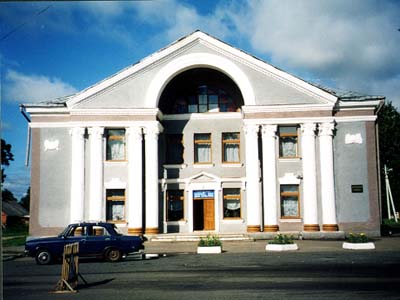 Liozno. The Chagalls’ house was once located here.
Liozno. The Chagalls’ house was once located here.
The boy from Liozno, Shneur-Zalman, showed his talent at a very early age. He attended a school of a local Talmudist but soon the man refused to teach him because the boy excelled him in knowledge. A year later a local rabbi characterized him in the community records, dated 1760, as: “an amazing scientist, a genius, highly knowledgeable in Talmud casuistry.” The young genius soon became widely popular in nearby towns and soon a rich man from Vitebsk, one of the heads of the local community, Jehuda-Leib Segal, decided to marry his daughter to Shenur-Zalman. Thus, the fifteen-year old boy got married and moved to Vitebsk. Later he became interested in Hasidism. The reasons for his interest were not in any way mercenary – he developed the philosophical background for a new doctrine – HaBaD. He was called “Alter Rebe”, which meant “the old teacher”. He founded a school, which was called an academy, in Liozno, for the students he picked. According to the 1880 statistics, 1536 people lived in Liozno, 65% of them – Jewish, or 997 people, to be more exact. The big Chagall family was among them. The town had four prayer houses and a Jewish college. There were 216 wooden houses, 135 of which belonged to Jews. Let’s imagine we are in Liozno in 1887, the year when Mark Chagall was born. Even though the painter was born in Vitebsk, he was frequently brought to Liozno to visit his numerous relatives. We are taking a walk from the central square along Vokzalnaya Street. We pass a gendarme and bow to his wife, who is looking out of the window. Then we cross a bridge, made of pine logs. Carts make a lot of noise when they cross it. It does not happen so often, though – in the morning, when they hurry to the market and in the evening, when they come back. The main street is quiet – one can see goats, wandering and picking up bits of straw or hay. 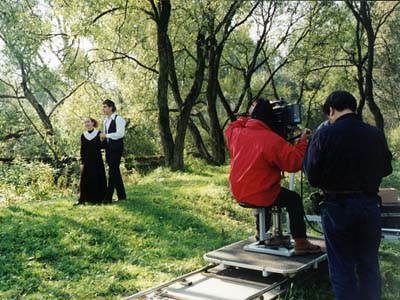 Liozno. Japanese filmmakers shooting a film about Chagall.
Liozno. Japanese filmmakers shooting a film about Chagall.
In front there is an Orthodox church, visited mostly by Latvians living in neighboring villages. The church is a stone building with domes and bells – the tallest in town. Behind the church there is a market where people from the neighborhood come to sell butter, poultry, vegetables, berries and apples. It is always crowded and here one can find out not only the local news, but also the news from all over Russia. One can hear Belarusian, Russian, Polish, Latvian, but most often Yiddish. According to many historians, the Segalls, Chagall’s ancestors, moved to Liozno from Slutsk at the beginning of the 18th century. Mark’s grandfather, Morduh-David, was a teacher at the local Heder and was a highly respected man. There was a synagogue next to the Heder, where Morduh-David had an honorary place by the eastern wall. This honor was given either to the richest people, who donated money, or to scholars, experts in the Torah and Talmud. Morduh-David died when he was a little over 60, in 1886, when the painter’s parents got married. He was buried by a river together with other “righteous men”. The letters on the tombstone are almost all erased, but one can still see the inscription: “Here lies…”  Liozno. Japanese filmmakers shooting a film about Chagall.
Liozno. Japanese filmmakers shooting a film about Chagall.
Grandmother used to come here with Mark. She could not cry – only moved her lips, whispering something: either talking to herself or praying. - Pray for us, David, please. This is me, your Basheva. Pray for you sick son Shatia, the poor Zusia and their children. Pray so that they always could be pure in God’s eyes.” The painter’s grandmother, his mother’s mother, is also buried in the cemetery in Liozno. Mark had never seen her because she died when she was very young in the first full moon of the Rosh Hashana, before Yom Kippur, in 1886. She had a heart disease. Liozno still has remains of the old Jewish cemetery. However, there is no fence around it and the cemetery itself is overgrown with shrubs and weeds. Nobody looks after it. The majority of the tombstones were taken apart and pilfered during the war and after it for the purpose of making house foundations. There are potatoes growing on the green hills. It would be impossible to find the graves belonging to Chagall’s relatives. The other grandmother – Baseva, Chagall’s father’s mother, was Mark’s close friend. “I was always friendly with my grandmother - a short, frail woman, consisting of her headscarf, a long skirt and a wrinkled face. She was a little over a meter in height… After becoming widowed, she married my other grandfather after receiving a rabbi’s approval. He was my mother’s father, also widowed. Both their spouses died in the year when my parents got married.” 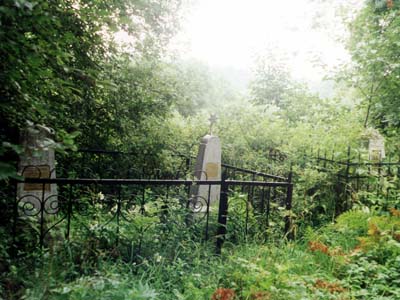 Liozno. The Jewish cemetery.
Liozno. The Jewish cemetery.
Baseva was a magician in the kitchen – she cooked really well. When he grew up, Mark Chagall remembered: “Grandmother always gave me some specially cooked meat, fried, baked or boiled. Which kind was that? I have no idea.” Her second husband, Mark’s grandfather Mendel Chernin was not a very hardworking man. They say he spent half of his life lying down and doing nothing, a quarter – in the synagogue and the rest of his time in a meat shop. He was a kind man, though. Mark loved him and wrote about him with respect: “a respectable old man with a long black beard”. Mark Chagall wrote about Liozno in his book “My life”: “I adored coming to Liozno, into your house, which smelled of cow skins! I also liked sheepskin. All of your ammunition was usually hanging at the entrance, right by the door: a hanger with clothes, hats, a whip and other things. Standing in front of the grey wall it looked like an odd figure, I could not really discern it. All this is my grandfather.” He was a butcher, a merchant and a hazzan… What a strange combination. Grandfather knew very well what was for people and what was for God. “There is a cow in the barn, looking at him stubbornly. Grandfather comes up to her and says: “Hey, listen, let’s tie your legs… we need to sell something, we need meat, do you understand?” And cow sighed and lay onto the ground… Grandfather separates the pluck and cuts the skin into pieces… That was his occupation! And it happened daily: two or three cows were slaughtered and the local people got fresh meat.” Once grandfather Mendel saw Mark’s drawing of a naked woman and immediately turned away, as if it was none of his business, as if a star fell onto the market square and no one knew what to do with it. “Back then I realized that grandfather, as well as my wrinkled granny, and, in general, all my close relatives did not take my art very seriously (what kind of art is it if it doesn’t resemble the original?) - they valued good meat much higher.” That odd man, who no one around understood, was very dear to Mark and, perhaps he was the one who showed the artist the most suitable place for all his characters: the roof, next to the chimney, close to stars and God and farther away from fussy and dissatisfied people. “It was a holiday: either Sukkot or Simhat-Torah.  Liozno. The River Moshna.
Liozno. The River Moshna.
Everyone is looking for grandfather, he has vanished. Where, where could he be? It turns out he climbed the roof, sat on the chimney and was chewing a carrot, enjoying good weather. What an amazing picture.” The memories of his strange grandfather, Mendel Chernin, inspired the painter, perhaps he even found out he possessed some of the grandfather’s traits. In the 60s he painted a picture which depicted Liozno. An old man is sitting nest to a chimney. He is being searched for and called but he is contemplating the eternal, he does not belong to the mundane world… The 20th century shocked Liozno residents with a flow of events. First it happened so that the place had a new owner – Nikolay Khlustin, a nobleman, who bet on the settlement in a card game and won. However, officially it is considered that the former owner just went bankrupt and the settlement was paid off as a debt. 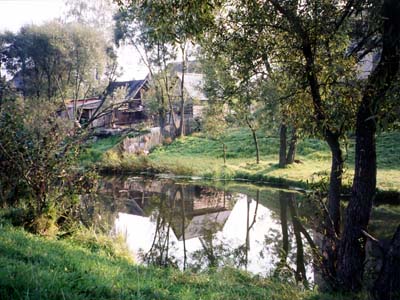 Liozno. The River Moshna.
Liozno. The River Moshna.
Nikolay Khlustin owned the place until 1917. The second event was not so significant, but still very important for the people – all the central streets were cobbled. The same year a new rabbi came to the town. His name was Yakov Jeruhim Mossarsky. Half a year later Liozno was struck by a strong fire. It started in the afternoon and by the evening half of the place had turned into ashes. Then the revolution broke into Liozno and the whole world. The revolution destroyed secular principles and ideals and, the most amazing thing was, that the local people took an active part in that. They believed that the new life was a guarantee of prosperity and equality for everyone. At the beginning of June, 1920, Mark Chagall left Vitebsk, never to come back here again. It means he never came back to visit Liozno, either. However, many of his relatives are still living here. We do not know whether Mark often thought about his small homeland after reaching the European heights but it is certain that his relatives from Liozno always wondered how he was living in France and invented all kinds of legends about him. Some old people told me what they had heard from their parents when they had been small. On summer evenings, while sitting outside, women would say things they knew absolutely for certain:  Liozno. Adamenki trench. Memorial on the site of the execution of Jews.
Liozno. Adamenki trench. Memorial on the site of the execution of Jews.
- Chagall is the wealthiest man in the world. He has a palace by the sea. He paints Liozno in his pictures. These pictures cost a fortune. - Who could ever think… - one of them sighed, thinking about her children. This is how they lived, crying and laughing, discussing the latest news, earning a living and taking care of their children and their future. The horrible merciless war destroyed the old settlement and executed its residents. On February 23rd, 1942, Soviet planes were bombing Liozno. The front line was only several kilometers away from the town. The Nazis decided that the main task was not to strengthen their positions but to shoot the local Jews. On February 24th all the Jews were taken in the direction of Adamenki and shot there. Ironically, it was the spot, where Mark Chagall loved painting. Here he was usually found by his relatives, who came to call him for lunch… Among the Jews, executed in Liozno were: David Zislevich Chagall (born in 1886), a barber; David’s children (Mark Chagall’s nephews): Olga, Shifra, Haim, and David’s wife Sonia. And there was another long list: Abrasha Chagall, Sara Chagall, Yesia, Belia and many others… The old Liozno is not there any more, neither are its residents. Chagall’s paintings are not only masterpieces but also a memory and an appeal to the world for tolerance and kindness… Liozno, October, 2008. |
|||
|
|
Jewish settlements in Vitebsk regionVitebsk • Albrehtovo • Babinovichi • Baran • Bayevo • Begoml • Beshenkovichi • Bocheikovo • Bogushevsk • Borkovichi • Braslav • Bychiha • Chashniki • Disna • Dobromysli • Dokshitsy • Druya • Dubrovno • Glubokoye • Gorodok • Kamen • Kohanovo • Kolyshki • Kopys • Krasnopolie • Kublichi • Lepel • Liady • Liozno • Lukoml • Luzhki • Lyntupy • Miory • Obol • Oboltsy • Orsha • Osintorf • Ostrovno • Parafianovo • Plissa • Polotsk • Prozorki • Senno • Sharkovshina • Shumilino • Sirotino • Slaveni• Smolyany • Surazh • Tolochin • Ulla • Verhnedvinsk • Vidzy • Volyntsy • Yanovichi • Yezerishe • Zhary • Ziabki • |
Main |
New publications |
Contacts |
Site map |
Vitebsk region |
Mogilev region |
Minsk region |